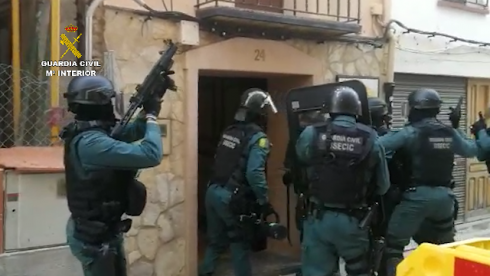In the first of an occasional series of articles on key issues affecting people in Andalucia, architect Liam Kellahar looks at dodgy lawyers and how to avoid them
If asked, I always recommend people to take professional advice for either buying or building a house. But even in the time I have lived in Spain, I have come across various cases of woeful mis-information, similar to those highlighted in the Olive Press last issue.
It is disappointing when professionals are part of the problem, not the solution. Especially when some of them are fellow architects. And it would certainly be disingenuous if I were to state that it is impossible for one of my brethren to stray from the path of righteousness.
So why is it so difficult to buy a house, risk free in Spain?
Well it can be summed up in a word, pícaro or picaresca. Okay so that’s two words, but they have the same derivation. There is no adequate English translation. All the examples I have seen have only a negative connotation and fail to encompass the positive feeling this word engenders for a Spaniard. It describes 16th Century characters of satirical Spanish literature, who lived by their wits rather than by dint of hard work. For English readers, probably the most famous is Sancho Panza; Don Quixote’s sidekick, penned by Cervantes. He was a good-for-nothing who spouted endless platitudes and refrains in order to avoid doing any work. Cast your mind back to 1980’s TV and the name Arthur Daley springs to mind. You have your definition of pícaro.
“But what has this got to do with the modern construction industry?” I hear you say.
It is quite simple really. The Spanish are great believers in personal responsibility. So if you are given bad advice, it is your fault for believing it. I know that sounds harsh, but if you keep this in mind you should reduce the number of problems you will have. So ask a lot of questions and satisfy yourself about the answers.
When choosing a lawyer or consultant find someone independent of the estate agent
If you think you are being told rubbish, say so and wave your arms about to emphasise your enthusiasm for your own point of view. But remember not to be too vehement. Spaniards do not respond well to aggression.
If you feel too British and do not think you have the blend just right, try some method acting. Imagine you are a Spanish abuela speaking to the teacher that has picked on her favourite nieto. You will find examples to study in every park and post office.
When choosing a consultant, try and find someone independent. Not your estate agent’s best mate. There is bound to be a conflict of interest.
When looking for a lawyer, ask around, see if friends and family know of a good one. Believe it or not the British Consulate keeps a list of lawyers that speak English. Go and see several. Which one do you feel you can trust and work with?
Now you are ready to start your purchase. Put on your ‘Buyer Beware’ hat. Trust nothing. Check everything. Sort out a traductor jurado de inglés. Get all legal documents translated into English so that you can go over them yourself. You want a certified translation, so the document you receive will be officially stamped. By the way, EU law states that a jurado translation can only be into your native language. You can find a list of names in your area on the internet.
Now what should you expect from your lawyer?
You will want a check at the Property Registry to show that there is no outstanding mortgage. What is the area of the property? And are those terraces, swimming pool etc. really included in your land? Get a levantamiento de lindantes, have the boundaries agreed in a walk round with your neighbours and get them marked. Oh and remember that in the courtroom battle of “Rock, paper, GPS grid reference,” GPS grid reference always wins. Check that the ubanisation is legal on the Plan Parcial. Make sure you get and fully understand the classification of the land.
If it is a new property make sure that it has been declared with the tax authorities for tax, the developer should be able to provide you with a Declaración de Obra Nueva and the escritura should mention both the house and the land. Now it is time to look at the PGOU (Plan General de Ordenación Urbana). Among other things this will tell you about the zoning of the land, and will describe allowable construction for various sites. So, a two rather than three storey house on your plot of land. Ask if there is an Avance copy, dealing with future development. All town halls have an architect, he may only be there a couple of days a week, but you can ask for an appointment. Also get a copy of any relevant sections to take away and get translated.
So before you sign anything, even a small reservation deposit agreement, here is a list of some of the documents you should have:
1) Escritura pública and a nota simple.
2) Paid-up receipts for annual property tax, IBI.
3) Catastral reference with the exact boundaries and area.
4) Paid-up receipts for all utility bills.
5) Paid-up receipts for the annual fees of the community of property owners, statutes of the community and the minutes of the last AGM.
Invest in a phrase book; it will give a list of useful phrases for most situations
If using an architect, he should be a member of a provincial Colegio Oficial de Arquitectos (COA). Mine is Córdoba, and any major building work should pass through the Colegio. The drawings and specification have their stamp showing that the project is visado. It will now be covered by the architect’s liability insurance. Then it is submitted to the ayuntamiento for approval.It’s a good idea to do some research yourself. You may find someone in the town hall that speaks a bit of English and can guide you.
But do not be like the lady I met, who insisted that all Spaniards spoke perfect English and presumably only spoke Spanish out of some form of devilment.
Remember estamos en España (we are in Spain) so do not expect the funcionario to speak fluent English or to know why you need his help. Look up the Spanish for your needs in a dictionary beforehand. If you only have a pocket version try the library for something better. Invest in a phrase book; it will give a list of useful phrases for most situations. Try to remember the useful introduction “disculpe” (I’m sorry to bother you, but…).
If you do not feel confident in your Spanish, organise an assisted visit. Ask about and try to learn the Spanish to be used in the meeting. Do not be passive and make sure that you get fully de-briefed after the meeting. Take notes and date them.
If you expect everything to be resolved in a single meeting, you will be disappointed, but do not get exasperated. Look on it as an opportunity to improve your Spanish. And finally, ask around. You will find people who have not only cautionary tales but also good luck stories. Try and work out what caused success and what caused failure.
I have to be honest and admit that the above advice is not the silver bullet that will protect you from all evil. When La Señora and I bought our house, we hired an independent lawyer. Two in fact. We sacked the first for being useless. We finally managed to buy the property with the aid of the second. He omitted to do some minor things correctly, but I put that down to his natural incompetence rather than dishonesty.
The dos and don’ts of building work…
FIRSTLY, DO be well informed. Books, such as “You and the Law in Spain” by David Searl (Santana Books) has a checklist of documents to get before you buy a house.
DO get the right licences. Here are some definitions:
Obra mayor: new works, refurbishment, extensions, demolitions or changes of use, which affect the external shape of the building, either partially or totally. Changes to the internal volume, internal distribution or structure. You will need a proyecto from an architect.
Obra menor: all works that are not technically complex, such as repairs, re-tiling (but not the roof structure), interior decoration, lightweight fences. But DO check with your town hall as they are the final arbiters.
When choosing a builder, DO make sure that they have a properly constituted company with the requisite insurance. DO ask for references and visit previous jobs.
DON’T believe those old chestnuts: “We DON’T use insulation, damp proof membranes, etc. in Spain.” Yes you DO, if you want the building to comply with Código Técnico de la Edificación (CTE) marzo 2006.
Sir Isaac Newton may have been English, but his Laws of Physics apply equally here in Spain. Gravity, heat, cold and rain will all affect the building in exactly the same way as they do in England.
A flat roof terrace without a waterproof membrane will leak, as Humphrey Bogart put it in Casablanca, “Maybe not today. Maybe not tomorrow. But some day you’ll regret it.” So make sure that you have the correct construction details.








This is a good article, but there is a better solution. Move to France!
Liked the article very much – very good advice there.
Butt – old song sheet – how about the professional organisations coming up with rules to deal with cirrupt and inept lawyers and architects?? Ohhh they do have them already – well then how about them taking responsibility for their members who are making Spain look like a banana republic to the rest of the world???
Any purchaser of off-plan property in Spain currently suffering any type of Bank Guarantee abuse please join the PETITION at:
“www.bankguaranteesinspain.com”
Kind regards
Keith
We lived in Spain and worked there for 25 years. We lost a sum of money in a business investment although we had legal advice, we had bad accountancy advice which cost us money on selling a property and now we are being investigated into an escrituta of obra nueva once again caused by a crooked solicitor. We speak fluent Spanish but it still happened. I will never ever return to Spain… It has been the worst 25 years of my life